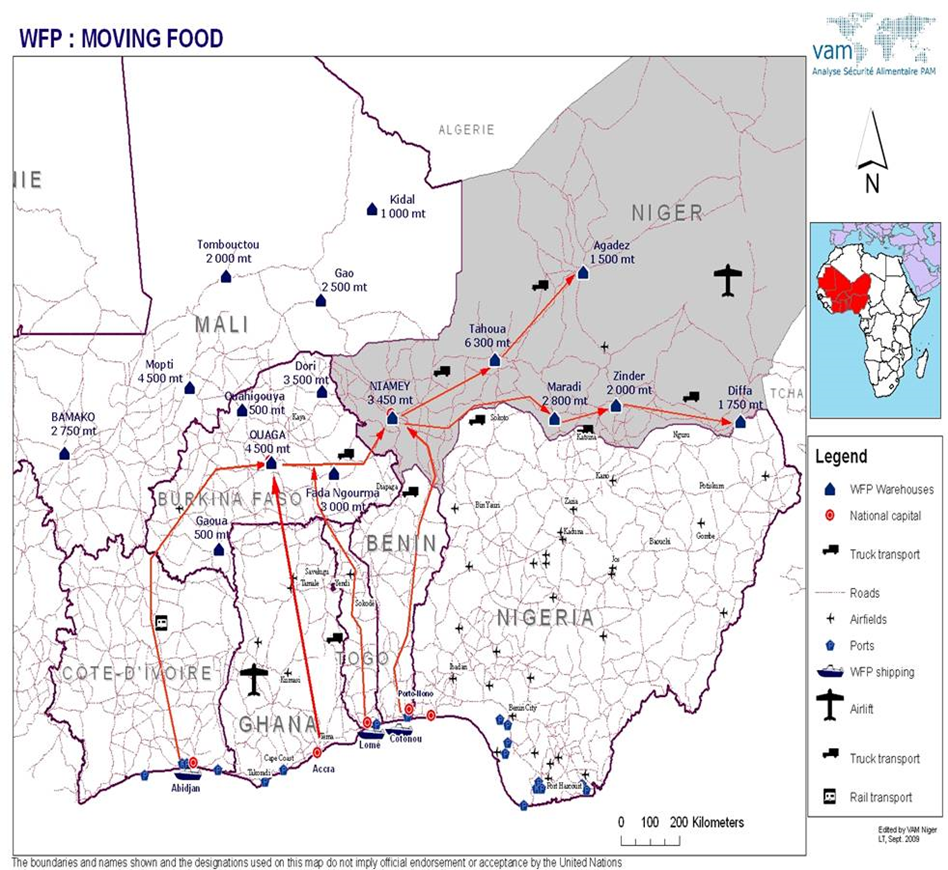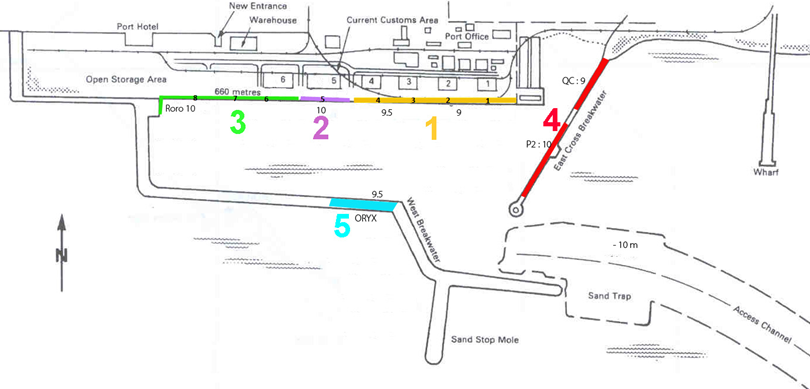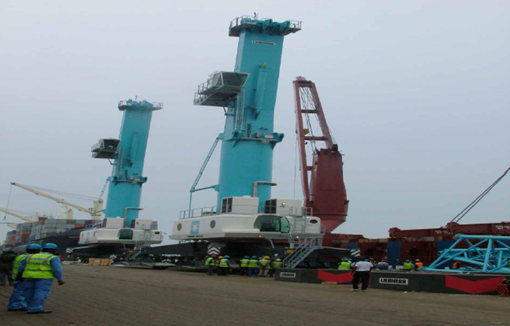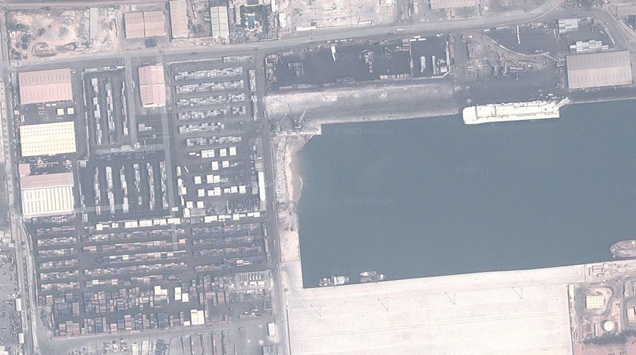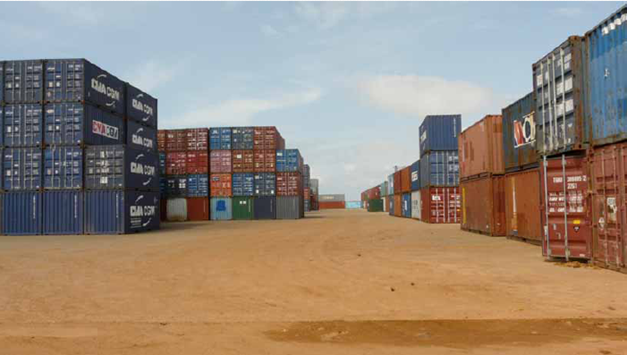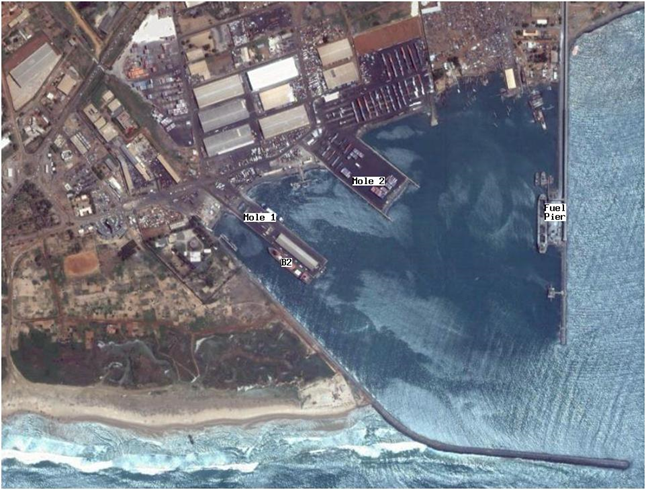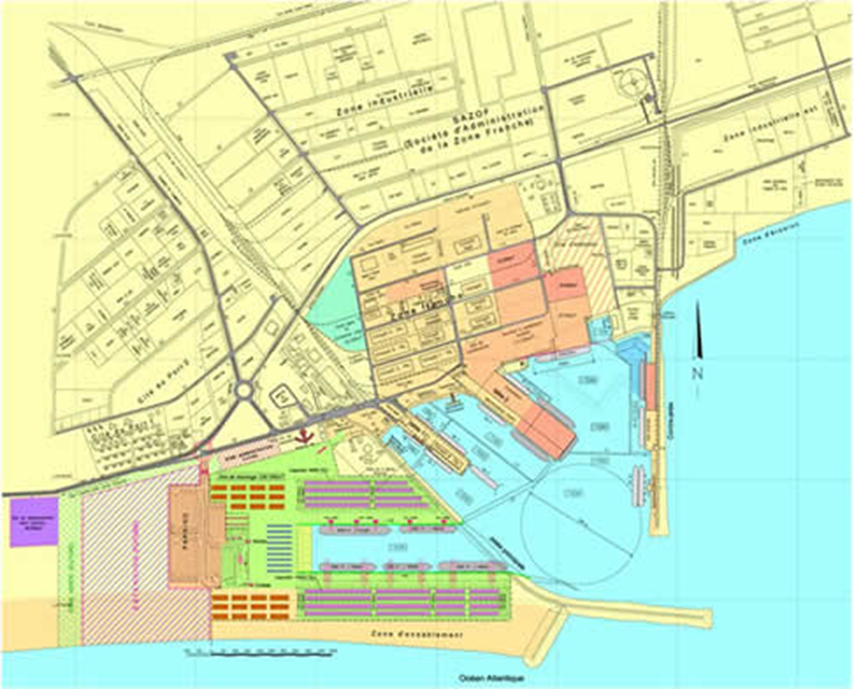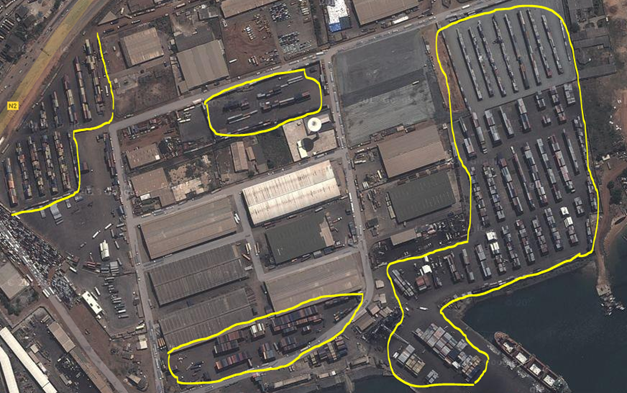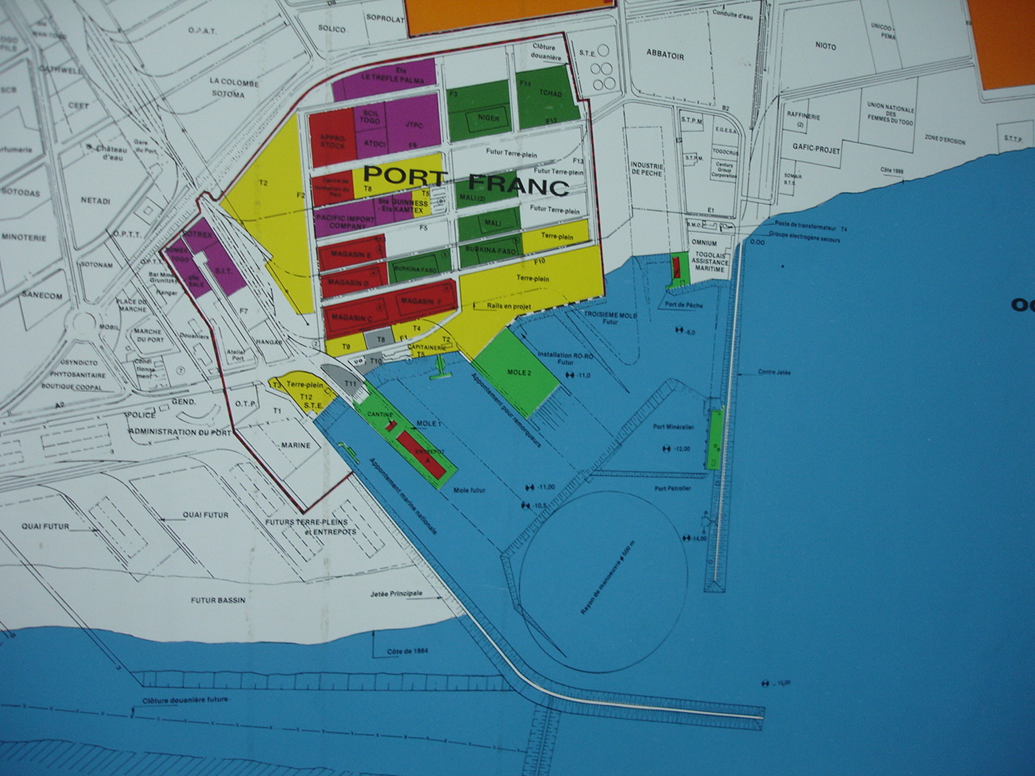2.1 Niger Port Assessment
Niger is a landlocked country with no access to the sea. The ports of Lomé, Togo and Cotonou, Benin are the most used ports, with the port of Tema, Ghana and Abidjan, Ivory Coast as backup ports. The assessment for these ports can be found in their respective countries LCAs.
2.1.1 Cote D'Ivoire Port Autonome d'Abijan
2.1.1 Niger Port of COTONOU
Key port information can also be found at: Maritime Database information on Niger Port of Cotonou
Port Overview
The Port of Cotonou is located in Benin and serves Niger, Nigeria, Togo, and Burkina a part from Benin itself. The port covers 400 thousand square meters, and its commercial quay contains four 155-meter berths, two 180-meter berths, one 220-meter berth for container vessels, and one berth for roll-on/roll-off cargoes. Warehouses cover 57 thousand square meters and include a 65-thousand square meter container depot and a free zone for Mali, Niger, and Burkina Faso.
Work was undertaken in 2011 to add to berths of total 550 meters with a depth of 13.5 meters. The old berths will also be dug out to attain 13.5 meters.
Port website: http://www.portdecotonou.com/
|
Port Location and Contacts |
|
|---|---|
|
Country |
Benin |
|
Province or District |
Cotonou |
|
Town or City (Closest location) with Distance (km) |
Name : Cotonou km: 0 |
|
Port's Complete Name |
Port Autonome de Cotonou |
|
Latitude |
6.189444 |
|
Longitude |
2.441667 |
|
Managing Company or Port Authority (If more than one operator, break down by area of operation) |
Port Autonome de Cotonou (PAC) |
|
Management Contact Person |
Standard: +229 21 31 52 80 / +229 21 31 28 90 |
|
Closest Airport and Frequent Airlines to / from International Destinations |
Airport Name: Cotonou Cadjehoun Airport Airlines: Air Burkina; Air Côte d’Ivoire; Air France; Air Mali; Arik Air; ASKY Airlines; Brussels Airlines; Camair-Co; Ceiba Intercontinental Airlines; COTAIR; Cronos Airlines; Ethiopian Airlines; Interair South Africa; Karinou Airlines; Kenya Airlines; Mauritania Airlines International; Royal Air Maroc; Sénégal Airlines; South African Airways; Toumai Air Chad; Trans Air Congo; Westair Benin. Cargo Airlines: Africa West Airlines; Air France Cargo |
Port Picture
|
Map reference number and Description |
Length (m) |
Draught (m) |
|
|---|---|---|---|
|
1 |
General cargo [1] |
135 |
9 |
|
1 |
General cargo [2] |
135 |
9.25 |
|
1 |
General cargo [3] |
135 |
9.25 |
|
1 |
General cargo [4] |
135 |
9.5 |
|
2 |
Car Carriers / Heavy general cargo [5] |
200 |
10 |
|
3 |
Containers [6] |
185 |
10 |
|
3 |
Containers [7] |
225 |
10 |
|
3 |
Containers and Ro-Ro vessels [8] |
250 |
10 |
|
4 |
Tanker vessels (oil, palm), and Bulk vessels (clinker, gypsum, wheat, fertilizer, ...) [QC] |
200 |
10 |
|
4 |
Tanker vessels (oil, palm), and Bulk vessels (clinker, gypsum, wheat, fertilizer, ...) [P2] |
180 |
9 |
|
5 |
Private berth for tanker vessels, or bunkering operations by Addax/Oryx [ORYX] |
200 |
10 |
Description and Contacts of Key Companies
The Cotonou Port Authority is a governmental entity that manages the port. For handling and manual labour SOBEMAP is a state-owned company that maintains monopoly for conventional handling, while Maersk and Bolloré competes in container handling through their subsidiaries COMAN and SMTC. A complete list of port partners, transit companies and more can be consulted at http://www.portdecotonou.com/index.php?option=com_content&view=article&id=32&Itemid=53&showall=1, where contact details are also provided.
4.4 Niger Port and Waterways Company Contact List
Port Performance
The port of Cotonou handled 4.1 million metric tonnes in 2006 - import, export and transit. This grew to 6.9 million tonnes in 2009 and have stabilised around that level since. That represents a growth of nearly 70% over 2006, and every year since has seen volumes far above planned or expected volumes. As a consequence port congestion has made its presence felt. The number of vessels calling the port declined, but the vessels calling were larger than before. The same period saw an increase of waiting time for container vessels increase from an average of 16 days to 34.6 days; with a peak of 67.6 days in 2008. The target set by the port is at four days and as such leaves ample room for improvements. On the other hand handling of container vessels have become more efficient and has decreased from two days average to 1.31 days in 2011, with a target set at one day. Average waiting time for trucks in 2011 was at 27.55 hours against a target of seven hours. The indicator has nevertheless seen steady improvements since 2008 when it was at 104 hours. Custom transit takes on average 2.93 days against a target set by the port of one day; this indicator has seen little evolution. The port of Cotonou has been criticised for being under too much political influence which is recognised be the Association for the Promotion of the port of Cotonou (APPC) who lists the conflict between port and city as the major challenge going forward.
The port of Cotonou has received funds from the Millenium Challenge Corporation to improve the infrastructure of the port. This work was undertaken in 2011 and is to be completed by 2013. This should allow the port to operate more effectively in the coming years. A layout of how the port will look can be seen further below.
|
Seasonal Constraints |
Yes / No |
From <month> to <month> |
|---|---|---|
|
Rainy Season |
Yes |
April to July |
|
Major Import Campaigns |
No |
n/a |
|
Other |
n/a | n/a |
| Handling Figures | Year 2006 | Year 2007 | Year 2008 | Year 2009 | Year 2010 | Year 2011 | Year 2012 |
|---|---|---|---|---|---|---|---|
| Vessel Calls | 1 393 | 1 407 | 1 299 | 1 300 | 1 011 | 989 | 1 054 |
| Container Traffic (TEUs) | 140 500 | 167 800 | 312 000 | 299 500 | 305 000 | n/a | n/a |
|
Handling Figures Bulk and Break Bulk |
Year 2009 |
Year 2010 |
|---|---|---|
|
Bulk (Million MT) |
2.5 ≈ 36 % |
2.5 ≈ 36 % |
|
Break bulk Million MT |
0.9 ≈ 13 % |
0.9 ≈ 13 % |
| Container Traffic (Million MT) |
3.5 ≈ 51 % |
3.6 ≈51 % |
Discharge Rates and Terminal Handling Charges
Port fees, which entails tugging, piloting, mooring and port dues will amount to about 5 000 000 XOF. General cargo handling is at about 5 000 XOF per tonne while bulk handling is around 2 500 XOF per tonne. For updates on convential handling charges SOBEMAP can be consulted. Container handling charges are found in the table below and updates can be obtained from COMAN and SMTC.
Berthing Specifications
|
Type of Berth |
Quantity |
Length (m) |
Maximum Draft (m) |
|---|---|---|---|
|
Conventional Berth |
5 |
740 |
10 |
|
Container Berth |
3 |
660 |
10 |
|
Silo Berth |
n/a | n/a | n/a |
|
Berthing Tugs |
3 |
||
|
Water Barges |
Yes |
Berth number 5 is the only berth dedicated for heavy general cargo vessels. The vessel is often lighted at the berth and then shifted towards berth 2, 3 or 4. Two private container terminal operated by SMTC (Bollore) and COMAN (Maersk) operate two shore cranes at quay 6/7-8. Tanker vessels are only allowed to dock and sail in daylight. Draught is calculated on the of basis high tide. Work was undertaken in 2011 to add to berths of total 550 meters with a depth of 13.5 meters. The old berths will also be dug out to attain 13.5 meters. Below is the port layout with the new berths included.
General Cargo Handling Berths
|
Cargo Type |
Berth Identification |
|---|---|
|
Imports - Bagged Cargo |
1-5 |
|
Exports - Bagged Cargo |
1-5 |
|
Imports and Exports - RoRo |
8 |
|
Other Imports |
Oryx, Q2, P2 |
Port Handling Equipment
The port equipment is managed by privately.
COMAN and SMTC handles containers and has suitable equipment that functions adequately. SOBEMAP who monopolises conventional handling is on the other hand criticised for lacking equipment and maintenance and overly relying on manual labour.
|
Equipment |
Available (Yes / No) |
Total Quantity and Capacity Available |
Comments on Current Condition and Actual Usage |
|---|---|---|---|
|
Dockside Crane |
Yes |
Quantity: 4 |
n/a |
|
Container Gantries |
Yes |
Quantity: 2 |
n/a |
|
Mobile Cranes |
Yes |
Quantity: 4 – Capacity: 140T |
n/a |
|
Reachstacker |
Yes |
Quantity: 7 – Capacity: 45T |
n/a |
|
RoRo Tugmaster (w/ Trailer) |
Yes |
Quantity: 13 |
Tug master & mafi |
|
Grain Elevator w/ Bagging Machines |
Yes |
Quantity: 1 – Capacity: 11T |
n/a |
|
Transtrainer |
n/a | n/a | n/a |
|
Forklifts |
Yes |
Quantity: 7 – Capacity: 4-16T |
n/a |
Container Facilities
The container storage area measures 91 000 square meters. Benin Terminal, subsidiary of Bolloré is equipped with two gantries. Two further private container terminal operators SMTC (Bolloré) and COMAN (Maersk) has two shore cranes at quay 6/7-8.
|
Facilities |
20 ft |
40 ft |
|---|---|---|
|
Container Facilities Available |
Yes |
Yes |
|
Container Freight Station (CFS) |
Yes |
Yes |
|
Refrigerated Container Stations |
Yes |
Yes |
|
Other Capacity Details |
||
|
Daily Take Off Capacity (Containers per day) |
n/a | |
|
Number of Reefer Stations (connection points) |
56 | |
|
Emergency Take-off Capacity (Give an indication) |
n/a | |
|
Off take capacity of gang shift (in Containers per shift) |
n/a | n/a |
Customs Guidance
Customs clearance at the port of Cotonou consists of eight steps, and if the procedure ever runs smoothly, can be completed in roughly seven hours. In practice two to three working days are to be expected. Clearance costs can be up to $750, depending on the size of container, number of trucks and where the cargo has shipped from. Customs officials, at least until recently, have been no strangers to corruption so costs may exceed this amount. In practice most UN agencies and NGO rely on freight forwarders to handle customs clearance.
A custom clearance manual for the port of Cotonou (in french), including transit procedure, can be found at http://www.finances.bj/IMG/pdf/manuel_de_procedure_version_corrigee.pdf. Se also the Customs Information section of the LCA.
Terminal Information
Multipurpose Terminal
A Ro-Ro berth is available, as well as a modern Ro-Ro terminal operated by Roro Terminal Benin SA. The terminal covers 4.5 hectares and has a capacity of 3 000 vehicles.
Grain and Bulk Handling
Bulk handling takes place on pier four and five, though the latter is reserved for the private company ORYX/ADDAX. The port has a grain silo with 11 000 tons capacity. Vegetable oil, and petroleum, tanks have a capacity of 43 700 cubic meters.
Main Storage Terminal
The storage facilities includes over 100 000 m2 worth of warehouses, three container terminals – 15 000 m2 container park, and paved open space storage covering 60 000 m2. Further there is a fish warehouse measuring in at 1 500 m2, 43m3of storage tanks and silo tanks with 11 000 tonnes capacity. There are free zone warehouses for Niger, Mali and Burkina Faso.
|
Storage Type |
Number of Storage Facilities |
Area (square meters) |
|---|---|---|
|
Bagged Cargo |
n/a |
57 000 |
|
Refrigerated Cargo |
n/a |
9 500 |
|
General Cargo |
n/a |
69 500 |
Stevedoring
Stevedoring was partly opened for competition in 1999, but the state owned company SOBEMAP still maintain monopoly on conventional handling. SMTC and COMAN, under Maersk and Bolloré respectively, has entered in to competition for handling of containers. Container handling has become significantly more effective since the liberation of the market, but conventional handling has deteriorated and handling can sometimes take weeks before completion. SOBEMAP has GETMA-Benin as their privileged partner for handling and transit.
Handling comprises loading and off-loading of ships as well as stocking and transporting the goods within the port.
Hinterland Information
Items are moved out of port by railway or by trucks. There is no railway in Niger so rail wagons have to be offloaded in Parakou, Benin, which is about half the distance between Cotonou and Niamey. Trucks are often congested at the port, and roads are generally in a bad condition – especially during the wet season.
Port Security
The port of Cotonou is ISPS compliant with the Direction de la Marin Marchandise charged with assuring conformity. The Port Security Officer is responsible for maintaining security levels. Access to the port is the responsibility of the Service des Formalités et d’Accès (Acces and formalities service) which restricts access to those who are issued permanent badges. Temporary access for 24 hours is granted to visitors who supply ID-papers, photos and a visit card or professional letter. Le Service Police Sécurité et Sûreté (Police service for security and assurance) is the public service who polices the port. They are responsible for the safety of technical installations, personal safety, ship inspection and prevention of theft. The police service is supported by private security enterprises that are contracted directly with the port and supplies guards and patrol the area. Le Service Environment, Accidents et Calamités (Service for the environment, accidents and calamities) handles spilllage, pollution and accidents. They rely on two old fire trucks that are prone to break-downs and often out of play. They will however receive support from the fire brigade of Cotonou in case of fires, but this nonetheless decreases respond time. No boat is available for the service to perform tasks such as rescuing people that have fallen overboard. The service is also said to be undermanned which affects it ability to perform.
Video surveillance is under implementation and a container scanner has supposedly been purchased. The number of thefts at the port fluctuates between 24 and 57 registered cases per year over the last six years.
|
Security |
||
|---|---|---|
|
ISPS Compliant (Yes / No) |
Yes |
|
|
Current ISPS Level |
1 |
Level 1 = Normal, Level 2 = Heightened, Level 3 = Exceptional |
|
Police Boats |
0 | |
|
Fire Engines |
2 |
2.1.2 Niger Port of LOME
Key port information can also be found at: Maritime Database information on Port of Lome
Port Overview
Niger is a landlocked country and therefore relies on neighbouring countries ports – Cotonou, Benin; Lomé, Togo; and Tema, Ghana are mostly used. Lomé is a free port, or free zone, which is strategically located in the sense that I can reach several West African capitals within a day. It is the only natural deep-water port on the West African coast that can potentially accommodate third generation ships. The port authority’s long term goal is to exploit this advantage to become the maritime hub for container trans-shipment in West Africa.
Construction is underway of a third pier which is scheduled to be completed by the end of 2013. It will have a draught of 16.6 meters that will enable the port to accommodate larger vessels and triple the port’s capacity within ten years. A new terminal is also underway. The port is run by the Port Autonome de Lomé (PAL) which is a state-owned company that oversees activities at the port and performs loading and offloading of wheat, hydrocarbons and minerals.
Port website: http://www.togoport.tg/
|
Port Location and Contacts |
|
|---|---|
|
Country |
Togo |
|
Province or District |
|
|
Town or City (Closest location) with Distance (km) |
Name : Lomé Km: 0 |
|
Port's Complete Name |
Port Autonome de LOME |
|
Latitude |
6.133333 |
|
Longitude |
1.283333 |
|
Managing Company or Port Authority (If more than one operator, break down by area of operation) |
Port Autonome de Lomé (PAL) |
|
Management Contact Person |
Direction Générale : 227 08 78 – Standard : 227 47 442 – Niger representation : +227 20 74 03 26 / +227 96 96 48 73 |
|
Closest Airport and Frequent Airlines to / from International Destinations |
Airport Name: Lomé-Tokoin Airport (Gnassingbé Eyadéma International Airport) Airlines: Air Burkina, Air Côte d’Ivoire, Air France, Air Mali, ASKY Airlines, Benin Golf Air, Brussels Airlines, Ceiba Intercontinental Airlines, Ethiopian Airlines, Royal Air Maroc, Toumaï Air Tchad. |
Port Picture
|
Map reference number and Description |
Length (m) |
Draught (m) |
|
|---|---|---|---|
|
1 |
General cargo (1) |
150 |
6 |
|
1 |
General cargo (2) |
150 |
10 |
|
1 |
General cargo (3) |
150 |
10 |
|
1 |
General cargo (4) |
150 |
8.5 |
|
2 |
Containers (5) |
230 |
11 |
|
2 |
Containers (6) |
210 |
12 |
|
3 |
Mineral berth |
190 |
12 |
|
Fuel pier |
Tanker berth |
187 |
14 |
|
|
New pier [under construction] |
1 050 (five berths) |
16.6 |
Description and Contacts of Key Companies
Handling of cargo is split between the port authorities and private companies. The Port Authority maintains handling of clinker; wheat; hydrocarbons and coasters. Container handling is performed by SE2M and Manuport, while conventional cargo handling is covered by SE3M and Manuport. SE2M and SEM3 are part of the Bolloré Africa Logistics group while Manuport is part of the Necotrans group. NITRA handles transit from the port to Niger, and Niger’s representative at the port is CNUT (conseil Nigéerien des Utilisateurs des Transports publics). Cotecna Inspection handles a mobile scanner and controls containers and vehicles in cooperation with the Customs office.
Among other companies operating in the port are Togo Terminal, a Container Terminal operator; Lome Multipurpose Terminal, a conventional terminal operator; SDV Togo, a Shipping and transit agency; SAGA Togo, a shipping and transit agency; STCM, a Shipping agency; GETMA and MSC, shipping companies; SDV-Damco, forwarding agent.
4.2.4 Niger Port and Waterways Company Contact List
Port Performance
The Lomé port handled about 8.2 million metric tonnes in 2011, this figure represents import, export and transit. Container traffic has seen the biggest development with a growth of 60 % in traffic since 2005. The growth rate has flattened over the last three year and the number of vessel calls has seen little evolution. The port of Lomé has nonetheless undertaken construction of a third pier and a new terminal which will double the port’s current capacity over five years and triple it over ten years. The maximum channel draft is 14 meters, which will be increased to 16.6 meters when the third pier is completed. This should allow vessels up to 7 000 TEU to dock at the port. The port has seen up to 63 hours in average waiting time in 2009 for general cargo and 24 hours for container vessels, 2011. Supposedly congestion has since dropped significantly since the introduction of fixed berthing windows and Lomé can boast a productivity of close to 35 movements per hour/ship which is among the best in Africa. The clearing speed of imported goods is less than impressive as it takes a minimum of four to five days. The current container terminal system is also criticised for being inconveniently located which entails additional handling. The port roads are in a very poor state. A final concern for the port is the presence of pirates in the region which notably threaten oil tankers.
|
Seasonal Constraints |
Yes / No |
From <month> to <month> |
|---|---|---|
|
Rainy Season |
Yes |
June to September |
|
Major Import Campaigns |
No |
n/a |
|
Other |
n/a | n/a |
|
Handling Figures |
Year 2005 |
Year 2006 |
Year 2007 |
Year 2008 |
Year 2009 |
Year 2010 |
Year 2011 |
Year 2012 |
|---|---|---|---|---|---|---|---|---|
|
Vessel Calls |
1 075 |
1 043 |
1 092 |
1 092 |
1 166 |
1 175 |
1 150 |
n/a |
|
Container Traffic (TEUs) |
204 614 |
215 898 |
237 891 |
296 109 |
354 480 |
339 853 |
350 000 |
n/a |
|
Handling Figures Bulk and Break Bulk |
Year 2009 |
Year 2010 |
Year 2011 |
|---|---|---|---|
|
Bulk (Million MT) |
2.5 ≈35 % |
3.1 ≈38.7 % |
3.3 ≈ 40 % |
|
Break bulk (Million MT) |
0.7 ≈10 % |
0.8 ≈10.4 % |
0.8 ≈ 10 % |
| Container Traffic (Million MT) |
4.1 ≈55 % |
4.1 ≈50.9 % |
4.1 ≈ 50 % |
Discharge Rates and Terminal Handling Charges
http://www.togoport.net/togoport/index.php?option=com_docman&task=doc_download&gid=3&Itemid=134
Berthing Specifications
|
Type of Berth |
Quantity |
Length (m) |
Maximum Draft (m) |
|---|---|---|---|
|
Conventional Berth |
4 |
150 |
6 – 6 – 8.5 – 10 |
|
Container Berth |
2 |
210 – 230 |
12 |
|
Silo Berth |
0 |
n/a | n/a |
|
Berthing Tugs |
Yes | ||
|
Water Barges |
Yes |
The port of Lomé has about 1 752 meters of berth which allow between eight and ten ships at the same time. For the moment there are two piers, one for general cargo and one for container handling. There is also docking for fuel and minerals and a dock for fishing vessels. Pier 1 is 336.5 meters long and 72 meters wide with four docking places. It rests on cement pillars which allow free movement of water under the pier and is designated to handle general cargo. Pier 2 is 250 meters long and 140 meters wide, it rests on a solid concrete foundation and can fit two container vessels at the same time. It is also the location for the multi-purpose container terminal. The oil jetty is 250 meters while the mineral dock measures in at 210 metres. The fishing dock is 60 meters and can accommodate up to nine trawlers.
A third pier is under construction and is planned to be finished by the end of 2013. This will add five berths totalling 450 meters of dockside and is to have a draught of 16 meters which will allow for larger vessels. The pier is to be equipped with four gantries that will enable the port to operate on vessels with at least 17 rows of containers. The container storage area is also under expansion and the addition of 24 RTGs is in the plans. The placement for the pier can be seen in the layout below.
General Cargo Handling Berths
|
Cargo Type |
Berth Identification |
|---|---|
|
Imports - Bagged Cargo |
1-4 |
|
Exports - Bagged Cargo |
1-4 |
|
Imports and Exports - RoRo |
5-6 |
|
Other Imports – Mineral and hydrocarbons |
Fuel and mineral berth |
Port Handling Equipment
The port equipment is managed privately?
Port equipment is managed privately with the exception of handling of hydrocarbons and minerals which is handled by the port authority. Container handling, at pier 2, is carried out by SE2M and Manuport while conventional handling at pier 1 is covered by SE3M and Manuport.
|
Equipment |
Available (Yes / No) |
Total Quantity and Capacity Available |
Comments on Current Condition and Actual Usage |
|---|---|---|---|
|
Dockside Crane |
Yes |
2 |
Four STS gantries are planned at new berth. |
|
Container Gantries |
Yes |
2 |
|
|
Mobile Cranes |
Yes |
Quantity: 4 Capacity: 104 T |
Panamax cranes, two more are ordered. |
|
Reachstacker |
Yes |
Quantity: 23 Capacity: 45 T |
TOS = Oscar |
|
RoRo Tugmaster (w/ Trailer) |
Yes |
n/a | n/a |
|
Grain Elevator w/ Bagging Machines |
No |
n/a | n/a |
|
Transtainer |
Yes |
4 |
24 RTGs are planned at the new berth. |
|
Forklifts |
Yes |
Quantity: 32 Capacity: 2 to 16 T |
n/a |
Container Facilities
The container storage area covers about 90 000 square meters and corresponds with the yellow areas in the layout and picture below.
|
Facilities |
20 ft |
40 ft |
|---|---|---|
|
Container Facilities Available |
Yes |
Yes |
|
Container Freight Station (CFS) |
Yes |
Yes |
|
Refrigerated Container Stations |
Yes |
Yes |
|
Other Capacity Details |
||
|
Daily Take Off Capacity (Containers per day) |
900 |
|
|
Number of Reefer Stations (connection points) |
100 |
|
|
Emergency Take-off Capacity (Give an indication) |
1 500 |
|
|
Off take capacity of gang shift (in Containers per shift) |
300 |
n/a |
Customs Guidance
The port of Lomé is a free port which means that handling and transferring of cargo can take place within the port areaThe custom clearing for transit involves nineteen steps which should normally take 1 415 minutes or about three working days. However, the process is subject to recurrent delays that may add up 1 535 minutes or about 3.2 working days – totalling in at 6.2 working days. Around four to five working days are generally to be expected. The reason for delays may be due to understaffing at the customs office, further the customs-release computer system is prone to failures. A detailed overview of the customs clearance process and steps to clear containers for transit can be found at page 31-33 and 81-89 in the West Africa Trade Hub Technical Report #47 accessible at http://www.watradehub.com/sites/default/files/resourcefiles/apr12/jan-2012-rev-final-corridor-ii-lome-ouaga-transport-and-logistics-costs-study.pdf. See also the Customs Information section of the LCA:
Terminal Information
Multipurpose Terminal
A multipurpose facility is available and operated by Bolloré African Logistics. Another terminal is under construction in connection with the third pier. RoRo facilities are available.
Main Storage Terminal
There are four warehouses of 7 500 square meters, labelled as “magasin C-F” in red in the layout above. Warehouse A on the pier measures at 5 000 squaremeters, while the B warehouse is used for fish. Six warehouses are designated for transit to Burkina Faso, Mali and Niger – dark green in the layout. In total there is about 115 000 square meters of storage available.
|
Storage Type |
Number of Storage Facilities |
Area (square meters) |
|---|---|---|
|
Bagged Cargo |
10 |
115 000 |
|
Refrigerated Cargo |
n/a | n/a |
|
General Cargo |
Open air |
200 000 |
Stevedoring
Stevedoring activities are mostly handled by private companies where SE2M and Manuport handles container traffic at pier 2 while SE3M and Manuport handles conventional cargo at pier 1. The Port Authority of Lomé maintains handling of hydrocarbons and minerals which takes place at the fuel and minerals pier. Pier 2 is set up to handle both vertical off-loading and horizontal off-loading (Ro-Ro). Stevedoring activities at the port comprises manual labour and operation of equipment for every step from offloading, storage, packing, stripping of containers and loading of trucks. Packing can be performed both at port and in facilities in the city.
Hinterland Information
Containers may be transported directly, but are generally stripped and loaded on to trucks (60-70%). Containers that are stripped are moved to a designated area of the port where, under customs surveillance, contents are manually offloaded. Due to equipment insufficiencies this procedure often experiences delays especially if the handling company has a ship to load or off-load.
Port Security
Security at the port complies with ISPS standards and the responsibility for security has been outsourced to an American private company. A team called “the Bees” patrol the area and keeps the gates. Entry is restricted to those carrying magnetic ID-cards and cars with pre-approved clearance. Surveillance cameras are installed and there is a mobile Gantry HVC scanner available to scan cargo. The American Coast Guard has inspected the port on a couple of occasions without indicating serious flaws. The port is currently in the process of applying for ISO certification for security.
Pirates in the area are well armed, violent and dangerous. Attacks can occur at anchorages and off the coast and usually at night. Some attacks resulted in the vessel being hijacked for several days where the vessel was ransacked and part cargo stolen (gas oil). Attacks have increased the over the last years.
|
Security |
||
|---|---|---|
|
ISPS Compliant (Yes / No) |
Yes |
|
|
Current ISPS Level |
1 |
Level 1 = Normal, Level 2 = Heightened, Level 3 = Exceptional |
|
Police Boats |
||
|
Fire Engines |
1 |
